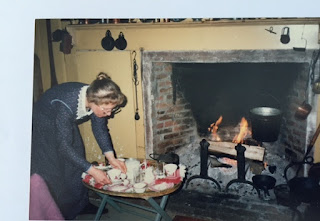Birch
Bark
Most afternoons, after a wonderful lunch of soup and
biscuits, Tasha and her corgis would retire for a short nap. Each time I visited, she
would remind me that when she was a young mother, her doctor had advised her to cultivate the habit of resting. Tasha had learned that even a thirty-minute nap
would refresh her creativity, her patience to be a good mother, and restore the
energy she would need to manage her homestead. Even after her children left the
nest to carve out their adult lives, Tasha continued to nap.
Left to entertain myself, once I made the mistake of
playing my recorder in the greenhouse, and later learned that the English
Country Dance tunes had floated up to Tasha’s bedroom! After that incident, I
either read or knitted by the hearth, or bundled up and headed outside for a
walk. Because I usually spent time with Tasha in either January or February
when my own farm was dormant, Vermont offered zero temperatures with brilliant blue skies or snow clouds. Coming from Michigan, I knew to
add a few more layers of clothing, wrap a scarf around my nose and accept
whatever the weather offered.
While birch trees grew throughout the woods near Tasha’s
home, their white-bark brightened the thicket of trees that lined the driveway.
Even when snowflakes fell, like torches the birch trees shimmered midst the
gray trunks and feathery evergreens. My boots crunched against the snow, and my
breath floated in clouds as I strolled towards the dirt road that lead to the
greater world beyond Tasha’s home. Chick-a-dees called as they flitted through
the woods, along with an occasional flash of a blue-jay’s wings. Wood smoke
scented the air. Sometimes, instead stopping at the mailbox, I walked on to
view a pond only a short ways from Tasha’s mailbox. More birches stood sentry
along that road, declaring that the land claimed a northern character. After
the invigorating constitutional, I picked up Tasha’s mail and headed back to
her home and the warm fire.
Once while discussing her birch bark canoe, Tasha talked
about how drawing or writing on birch bark was great fun. I confessed that
because so few birches grew on my farm, that I had never stripped one of them
and tried writing on the bark.
“In the spring, when the sap is running, I will send you
some,” Tasha said. “Your children will especially enjoy drawing on it.”
I thanked her, grateful once again for Tasha’s
encouragement to broaden my experiences and creativity. Later that week, I flew
back to Michigan, and forgot about her promise. But sometime in June, a large
box arrived in the mail addressed with Tasha’s familiar handwriting. I cut it
open and removed a heavy roll of birch bark. With black streaks slashed the
white and small nubs provided texture that would enhance anything drawn upon
the skin of a birch. I cut off a few strips from the roll, and my sons sketched
corgis and goats on them, and later stored the bark in their play house.
While preparing for this year’s you-pick blueberry
season, I swept and tied the playhouse that now serves as a weigh-in location,
and noticed the roll of birch bark. How could I have forgotten this wonderful
piece of Tasha’s life that exemplified her love of nature and art?







